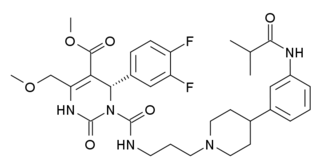Related Research Articles
The melanocyte-stimulating hormones, known collectively as MSH, also known as melanotropins or intermedins, are a family of peptide hormones and neuropeptides consisting of α-melanocyte-stimulating hormone (α-MSH), β-melanocyte-stimulating hormone (β-MSH), and γ-melanocyte-stimulating hormone (γ-MSH) that are produced by cells in the pars intermedia of the anterior lobe of the pituitary gland.
Melanin-concentrating hormone (MCH), also known as pro-melanin stimulating hormone (PMCH), is a cyclic 19-amino acid orexigenic hypothalamic peptide originally isolated from the pituitary gland of teleost fish, where it controls skin pigmentation. In mammals it is involved in the regulation of feeding behavior, mood, sleep-wake cycle and energy balance.
Melanocortin receptors are members of the rhodopsin family of 7-transmembrane G protein-coupled receptors.
Neuropeptide Y receptors are a family of receptors belonging to class A G-protein coupled receptors and they are activated by the closely related peptide hormones neuropeptide Y, peptide YY and pancreatic polypeptide. These receptors are involved in the control of a diverse set of behavioral processes including appetite, circadian rhythm, and anxiety.
Lipotropin is the name for two hormones produced by the cleavage of pro-opiomelanocortin (POMC). The anterior pituitary gland produces the pro-hormone POMC, which is then cleaved again to form adrenocorticotropin (ACTH) and β-lipotropin (β-LPH).
The galanin receptor is a G protein-coupled receptor, or metabotropic receptor which binds galanin.
Transforming growth factor beta (TGFβ) receptors are single pass serine/threonine kinase receptors that belong to TGFβ receptor family. They exist in several different isoforms that can be homo- or heterodimeric. The number of characterized ligands in the TGFβ superfamily far exceeds the number of known receptors, suggesting the promiscuity that exists between the ligand and receptor interactions.

Growth hormone secretagogue receptor(GHS-R), also known as ghrelin receptor, is a G protein-coupled receptor that binds growth hormone secretagogues (GHSs), such as ghrelin, the "hunger hormone". The role of GHS-R is thought to be in regulating energy homeostasis and body weight. In the brain, they are most highly expressed in the hypothalamus, specifically the ventromedial nucleus and arcuate nucleus. GSH-Rs are also expressed in other areas of the brain, including the ventral tegmental area, hippocampus, and substantia nigra. Outside the central nervous system, too, GSH-Rs are also found in the liver, in skeletal muscle, and even in the heart.
The RAR-related orphan receptors (RORs) are members of the nuclear receptor family of intracellular transcription factors. There are three forms of ROR, ROR-α, -β, and -γ and each is encoded by a separate gene, RORA, RORB, and RORC respectively. The RORs are somewhat unusual in that they appear to bind as monomers to hormone response elements as opposed to the majority of other nuclear receptors which bind as dimers. They bind to DNA elements called ROR response elements (RORE).
The EGF module-containing Mucin-like hormone Receptors (EMRs) are closely related subgroup of G protein-coupled receptors (GPCRs). These receptors have a unique hybrid structure in which an extracellular epidermal growth factor (EGF)-like domain is fused to a GPCR domain through a mucin-like stalk. There are four variants of EMR labeled 1–4, each encoded by a separate gene. These receptors are predominantly expressed in cells of the immune system and bind ligands such as CD55.

Melanocortin 4 receptor (MC4R) is a melanocortin receptor that in humans is encoded by the MC4R gene. It encodes the MC4R protein, a G protein-coupled receptor (GPCR) that binds α-melanocyte stimulating hormone (α-MSH). In mouse models, MC4 receptors have been found to be involved in feeding behaviour, the regulation of metabolism, sexual behaviour, and male erectile function.

Corticotropin-releasing hormone receptor 1 (CRHR1) is a protein, also known as CRF1, with the latter (CRF1) now being the IUPHAR-recommended name. In humans, CRF1 is encoded by the CRHR1 gene at region 17q21.31, beside micrototubule-associated protein tau MAPT.

Melanin-concentrating hormone receptor 1, also known as MCH1, is one of the melanin-concentrating hormone receptors found in all mammals.

Melanin-concentrating hormone receptor 2 (MCH2) also known as G-protein coupled receptor 145 (GPR145) is a protein that in humans is encoded by the MCHR2 gene.

ATC-0175 is a drug used in scientific research, which is a selective, non-peptide antagonist at the melanin concentrating hormone receptor MCH1. In animal studies it has been shown to produce both anxiolytic and antidepressant actions, but without sedative or ataxic side effects.

SNAP-94847 is a drug used in scientific research, which is a selective, non-peptide antagonist at the melanin concentrating hormone receptor MCH1. In animal studies it has been shown to produce both anxiolytic and antidepressant effects, and also reduces food consumption suggesting a possible anorectic effect.
GW-803430 (GW-3430) is a drug used in scientific research and is a selective non-peptide antagonist at the melanin concentrating hormone receptor MCH1. In animal studies it has anxiolytic, antidepressant and anorectic effects.

SNAP-7941 is a drug used in scientific research, which is a selective, non-peptide antagonist at the melanin concentrating hormone receptor MCH1. In initial animal studies it had promising anxiolytic, antidepressant and anorectic effects, but subsequent trial results were disappointing, and the main significance of SNAP-7941 is as the lead compound from which more potent and selective antagonists such as SNAP-94847 were developed, although it continues to be used for research into the function of the MCH1 receptor.

NGD-4715 is a drug developed by Neurogen, which acts as a selective, non-peptide antagonist at the melanin concentrating hormone receptor MCH1. In animal models it has anxiolytic, antidepressant, and anorectic effects, and it has successfully passed Phase I clinical trials in humans.

Olivier Civelli is a molecular biologist, a researcher in the field of neuropharmacology and an educator. He is the Eric L. and Lila D. Nelson Professor of Neuropharmacology at University of California, Irvine. He is also a Professor in the Department of Developmental and Cell Biology at University of California, Irvine. He is most known for his work in advancing understanding of neurotransmission and his impact on drug discovery.
References
- ↑ Handlon AL, Zhou H (2006). "Melanin-concentrating hormone-1 receptor antagonists for the treatment of obesity". J. Med. Chem. 49 (14): 4017–22. doi:10.1021/jm058239j. PMID 16821761.
- ↑ Luthin DR (2007). "Anti-obesity effects of small molecule melanin-concentrating hormone receptor 1 (MCHR1) antagonists". Life Sci. 81 (6): 423–40. doi:10.1016/j.lfs.2007.05.029. PMID 17655875.
- ↑ Shimazaki T, Yoshimizu T, Chaki S (2006). "Melanin-concentrating hormone MCH1 receptor antagonists: a potential new approach to the treatment of depression and anxiety disorders". CNS Drugs. 20 (10): 801–11. doi:10.2165/00023210-200620100-00002. PMID 16999451. S2CID 32524553.
- ↑ Bohlooly-Y M, Mahlapuu M, Andersén H, Astrand A, Hjorth S, Svensson L, Törnell J, Snaith MR, Morgan DG, Ohlsson C (2004). "Osteoporosis in MCHR1-deficient mice". Biochem. Biophys. Res. Commun. 318 (4): 964–9. doi:10.1016/j.bbrc.2004.04.122. PMID 15147966.
- ↑ Monti JM, Torterolo P, Lagos P (August 2013). "Melanin-concentrating hormone control of sleep-wake behavior". Sleep Med Rev. 17 (4): 293–8. doi:10.1016/j.smrv.2012.10.002. PMID 23477948.
- ↑ Saito Y, Maruyama K (2006). "Identification of melanin-concentrating hormone receptor and its impact on drug discovery". Journal of Experimental Zoology Part A: Comparative Experimental Biology. 305 (9): 761–8. doi:10.1002/jez.a.311. PMID 16902961.
- ↑ McBriar MD (2006). "Recent advances in the discovery of melanin-concentrating hormone receptor antagonists". Current Opinion in Drug Discovery & Development. 9 (4): 496–508. PMID 16889232.